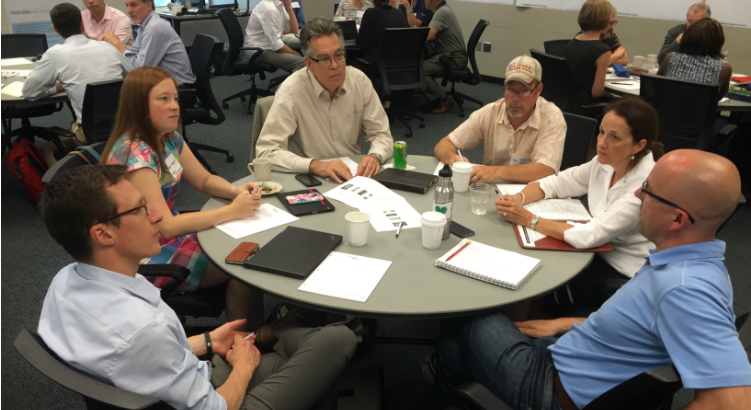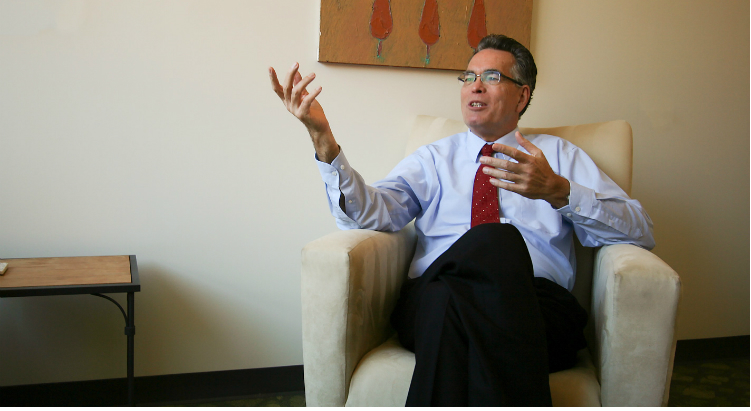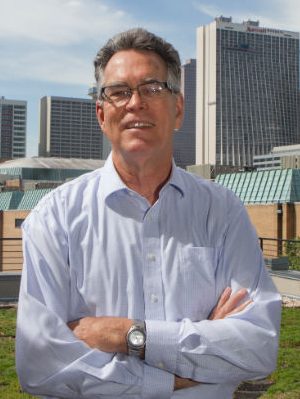Dennis Creech wasted no time jumping into a new gig when he retired in December from Southface Energy Institute.
In 1978, Creech co-founded the nonprofit, which hosts its annual Greenprints Conference this week at Georgia State University. He oversaw Southface’s growth over the next 38 years into one of the nation’s leading green building and energy efficiency organizations. Then, in January, the 66-year-old South Carolina native became a fund advisor at the Kendeda Fund. His primary mission: To “leverage” the Living Building at Georgia Tech so that a deeper green version of green building — regenerative design and construction — takes firm hold in the Southeast.
Along with other Kendeda associates and Georgia Tech staff, I’m part of that same leverage team. I interviewed Creech last week to better understand how his new role might advance his life’s work as an advocate for sustainable design and construction.
You left Southface having overseen dozens of successful green building efforts. But now you’re focused on this relatively small, deep-green program called the Living Building Challenge. What is it about LBC that has drawn your interest?
There are a lot of words we use to describe a building standard that goes beyond doing less harm and aspires to actually improve the environment — restorative, regenerative. That ambition is one part of the Living Building Challenge that’s very admirable.
But, in my mind, there’s something else just as significant: It’s holistic. It’s not just about the environment in isolation, without considering its connection to people. I think the Living Building Challenge recognizes that to be restorative to the planet, it has to address the needs of people.
How does that emphasis on people play out in the standard itself?
For example, it recognizes beauty, and the site — the environment around the building. It places a big emphasis on health — not just the health of the people who occupy the building, but also those who clean it and those who make the materials that are used in its construction. The Living Building recognizes that different communities are affected differently by a building. It’s never just about the building.
Historically environmentalists have focused on things like protecting wilderness, protecting resources, preventing big global problems. I don’t mean to say that those things aren’t important. But there’s been a growing recognition that to truly address environmental issues you have to address the role that people will play and how people will be affected. Environmental leaders are now some of the leaders in the discussion about equity, and that hasn’t always been the case.
You see a very similar thing happening in the design community, where architects have started to focus on ways to reduce the impact of buildings on these major sustainability issues, and at the same time they’ve embraced the idea that you can’t really separate the broader idea of social responsibility from those issues.
A lot of people who are very passionate about improving the environmental performance of buildings may see these issues as separate, however. Help me understand why you view them as so bound together.
One example is in the materials requirements of the Living Building. Some components — certain types of insulation, for example — really can help a building’s performance but aren’t allowed to be used in a Living Building because they violate the Red List [ban on toxic materials].
Or PVC [used in plumbing pipes]. It may put some risk on the occupants of the building, but the really big problem is for the person who’s working in the plant involved in manufacturing the product. That’s where you see dioxins released in the environment. Can you really say that a building is green if carcinogens are created as part of the overall process of creating that building?
How do you see that commitment to equity reflected in the Living Building at Georgia Tech?
Ideally, every decision about the building is made through an equity lens. The building will have an impact on the environment of the surrounding community, so are there measures to employ local people in the construction [and] the ongoing operation of the building? Does the design of the building and the programs it will offer encourage engagement with the local community? We hope the building at Georgia Tech will be a gathering spot for students and others. Will the design encourage mental and physical health?
Georgia Tech brought a lot of assets to the table. Obviously, they had strong academic programs that are relevant to buildings, energy, materials and so forth. But I’ve been really impressed by the facilities and planning staff that over the last decade or so has been stressing high-performance buildings and more resilient landscapes.
Yes, that’s definitely the case. But as we’ve worked on this project, the thing I’ve been most impressed by from both Georgia Tech and the design and construction team is that I’ve not yet heard anyone say, “Why are we doing this?” Or, “We can’t do this.” It’s all been about how to do it.
Tech’s a great owner and shares the vision of solving these challenges by addressing how so many of them fit together. So there’s so much of an opportunity here to do things in a way that sets a great example and is transformative.

Which brings us to one of the main goals of the Living Building at Georgia Tech: to leverage the project so that some of these regenerative ideas are adopted by other projects across the Southeast. What regenerative features of LBC are particularly ripe for adoption elsewhere?
Net positive energy. The price of electricity generated by solar has plummeted over the past few years and continues to drop. The main challenge for more widespread adoption in the Southeast is cumbersome regulations that discourage a fair market for renewable energy sources like solar and wind.
Another area is water. As Georgia and the Southeast continue to grow, water resources will become more scarce and costly. Plus, the processing of potable water and the treatment of wastewater are energy intensive. So, the Living Building at Georgia Tech stretches our thinking on the connection between energy and water and on how we can dramatically reduce water waste in buildings and process wastewater onsite.
Finally there are the building materials. As I mentioned earlier, many commonly used materials contain unhealthy chemicals and their manufacture can pose environmental risks. The Living Building Challenge prohibits Red List of chemicals from being used in the design, construction and operation of the building. That’s beginning to transform the building products industry because the expanding market requires the transparency that makes it easier for consumers to identify manufacturers that are committed to removing harmful chemicals. Our hope is that materials manufacturers in the Southeast and beyond begin to take advantage of this Red List-free market.
What kinds of building owners do you think are good prospects to adopt some of these regenerative features?
Net positive energy and net positive water may add to the initial cost of a building, but they save money over time because they reduce operating expenses. There’s this false argument that energy and water efficiency represent added costs. But long-term building owners are a prime market to adopt regenerative features because they’re the ones who will naturally appreciate that that efficiency is an attractive investment. It actually reduces financial risk and reduces costs over time.
Another group that’s likely to adopt regenerative design principles are building owners who value the health of occupants. Daylight, fresh air, pollutant-free spaces that connect to the outdoors — these kinds of features are good for the health of building occupants, and they’ve also been shown to improve productivity.
How long will it take for truly regenerative features to become more widespread, or even mainstream?
The barriers to regenerative features becoming mainstream are not technological. They’re policy driven. Public policy now subsidizes energy waste and water waste, and it doesn’t place enough value on the health benefits of regenerative design. It’s unfortunate because the external costs of waste are greater than the costs of regenerative design.
But I’m an optimist. The more successes we have, the more programs like the Living Building will demonstrate the technological feasibility of regenerative design, and that will generate support for enacting policies that break down outdated regulations.
It wouldn’t be the first time for materials and design to drive changes in policy and in the industry. Do changes in the past tell us anything about how things might progress in the future?
Look at huge advances in energy, efficiency and the technology around it. We now have windows that insulate almost as well as walls, and they bring in daylight while blocking summer heat.
LED lighting uses a fraction of the energy of the incandescent lightbulb, and we’re just beginning to see this dramatic revolution in lighting technology. We’re seeing lighting fixtures that can tell when somebody’s using a space, but also what kind of light they need when they’re using it. Sensors are doing diagnosis on heating and cooling equipment. They can tell when there’s going to be a problem that needs servicing before it develops.
I don’t think anybody could have imagined all this 30 or 40 years ago. The technological advances will continue, but some of the changes are in a funny way circling back in the other direction — more about behavior.
One of the wonderful things about the Living Building is that we are beginning to realize that we need to design with nature rather than apart from it. So a whole new realization — and this gets back to the people part — is that occupants can play a role in the green-ness of the building. Why should you use all this energy needlessly because people aren’t willing to wear a sweater in the wintertime?
Find out more about this week’s Greenprints conference
What about the actual practice of design and construction? How have professionals and the building industry changed with respect to green building?
Well, we don’t have to define what the term “green building” means anymore. Builders are very familiar with the basic ideas. They know: “I can make my building greener.” And that’s especially the case in commercial construction. So it’s become something that they see as valuable and worthwhile.
Now, the challenge is how do we continue to raise the bar? How do we continue beyond basic green principles and begin to make buildings actually restorative?
The good news is that we’ve raised the floor. One way we’ve done that is with the building code. Another is the value that people see in getting green certified. There’s a high percentage of commercial buildings in Atlanta that builders and owners make sure is green certified simply because they know they’ll get better rents and better occupancy.
But the reality is that still most renovations and new buildings don’t go for any sort of green certification.
The good news is that most buildings — even those receiving no green certification of any sort — are greener in a lot of ways than buildings 30 years ago, because the codes are better and the equipment is much, much less wasteful. And also builders and the trades know so much more about best practices.
But we have to do much better still. One big problem is that the person who designs and builds very often isn’t the person who owns it or occupies it.
Another barrier is that the full price of energy, and I would argue water, is not reflected in the cost. This gets back to the policy part of it. We subsidize the use of dirty energy, and the inefficiency. One way we do pay for that is with our health. If we reflected the full cost of fossil fuels on asthma and other lung disease, we would see a dramatic shift toward renewable energy.
It’s similar for water. Rather than sweep the sidewalk in front of their building, people actually hose it off, because water is dirt cheap. So we pay millions of dollars to build new treatment plants … because we don’t use a broom to sweep our sidewalk.
Despite the increased emphasis on health and equity, a lot of the big issues still seem to revolve around energy and water.
And, of course, energy and water are connected. One of the largest uses of freshwater in Georgia is for energy — power plants. So when we waste energy, we use vast amounts of water. And likewise the largest user of energy for the city of Atlanta is the water treatment plant.
The Living Building Challenge gets that. The Living Building understands the connection between the cost of water and the cost of energy. When you have to produce all the energy onsite, and you have to get all the water onsite and treat it and release it back into nature before it leaves the site, you start to think about solving these problems in a very different way.
The International Living Future Institute (which operates the Living Building Challenge) is incredibly ambitious. Because LBC is so comprehensive, ILFI has ended up creating additional programs like Living Communities Challenge and the Just Label and the Declare Label to deal with some of the related issues.
I think they understand the holistic nature of the built environment. Ultimately it gets into a values discussion about consumerism and materialism. I don’t think it’s a bad thing, if we end up asking, how do we make the planet sustainable, not just buildings? This also connects back to equity. Just because I can afford to waste water or energy, should I? My waste drives up the cost of these resources for others, and my waste can harm the health and quality of life of others, especially low income communities where power plants and wastewater treatment plants are typically sited.

Do you think we’re at a point that buildings can actually have a net beneficial impact? Can a Living Buildings actually heal the planet?
You have to be careful about overselling it. I don’t know that every building will do that. But you can look at it on individual projects and say they achieve pieces of that healing.
For example, the Georgia Tech building will replace a parking lot with a building that will used reclaimed water for its operational needs, which is overall better for the environment. But the cars that used to park on that lot aren’t going to disappear. They’re going to park in a new deck, which will deal with the runoff more sensibly than the parking lot.
But the building will be required to produce more energy than it uses, and all that energy will be clean and renewable. That’s a pretty significant thing.
So how far can a regenerative building get at this point?
You can definitely make the argument for energy and water. But stretching it to every environmental criteria we have — biodiversity, the mining of minerals, things like — those are ambitious. But it’s good to be moving in this direction.
Everybody’s focused right now on the materials because it’s a very difficult area. How are we restorative about minerals that are mined to into those materials. At some point, will we start mining landfills to extract the minerals? Will we be recycling much more to pull the minerals back into use? Will we be moving more and more to a circular economy and move away from extracting minerals?
That’s one of the huge challenges we have to building a truly restorative economy. But I don’t think anyone believed a few years ago that solar would be in such a competitive position despite the low cost of fossil fuels. Or that so many different technologies would do so much to enhance efficiency. We’ve met challenges before.
Read more Q&As with Dennis Creech and a brief profile on his Profile page.


